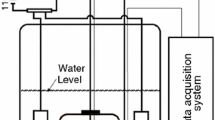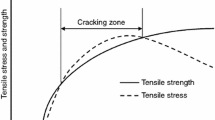Abstract
For freshly cast concrete structures in presence of strong restraints, the thermal stresses associated with the heat of hydration of cement can lead to cracking, with detrimental consequences from both aesthetical and serviceability points of view. In this paper, a methodology for the thermo-mechanical analysis of concrete structures is presented, along with an application to a highly restrained slab.
Access this chapter
Tax calculation will be finalised at checkout
Purchases are for personal use only
Preview
Unable to display preview. Download preview PDF.
Similar content being viewed by others
References
de Borst, R. and van den Boogaard, A. Finite-element modeling of deformation and cracking in early-age concrete. J. Eng Mech Div., ASCE, 1994;120(12): 2519–2534.
Cervera, M., Faria, F., Oliver, J. and Prato, T. Numerical modelling of concrete curing, regarding hydration and temperature phenomena. Computers and Structures, 2002;80(18–19): 1511–1521.
Breugel, K. Simulation of hydration and formation of structure in hardening cement-based materials. Doctoral Thesis, Delft, 1991.
Breugel, K. Prediction of temperature development in hardening concrete. In: Prevention of thermal cracking in concrete at early ages. Report 15, R. Springenschmid, E&FN SPON, 1998.
Ruiz, J., Schindler, A., Rasmussen, R., Kim, P. and Chang, G. Concrete temperature modeling and strength prediction using maturity concepts in the FHWA HIPERPAV software, 7th International Conference on Concrete Pavements, Orlando, USA, 2001.
De Schutter, G. Thermal properties. In: Early age cracking in cementitious systems. Report 25, A. Bentur, RILEM Publications s.a.r.l., 2001.
Reinhardt, H., Blaauwendraad, J. and Jongedijk, J. Temperature development in concrete structures taking account of state dependent properties, Int. Conf. Concrete at Early Ages, Paris, France, 1982.
Morabito, P. Methods to determine the heat of hydration of concrete. In: Prevention of thermal cracking in concrete at early ages. Report 15, R. Springenschmid, E&FN SPON, 1998.
Wadsö, L. An experimental comparison between isothermal calorimetry, semi-adiabatic calorimetry and solution calorimetry for the study of cement hydration., Nordtest report TR 522, 2003.
Bentz, D. Three-dimensional computer simulation of Portland cement hydration and microstructure development. J. Am. Ceram. Soc., 1997;80(1).
Maekawa, K., Chaube, R. and Kishi, T. Modelling of concrete performance, E&FN SPON, 1999, 308.
Rostásy, F., Gutsch, A. and Krauß, M. Computation of stresses and cracking criteria for early age concrete - Methods of iBMB. IPACS, Task 3, 2001.
Bazant, Z. and Osman, E. Double power law for basic creep of concrete. Materials and Structures, Research and Testing, 1976;9(49): 3–11.
Azenha, M. Behaviour of concrete at early ages. Phenomenology and thermo-mechanical analysis. (in Portuguese). MSc Thesis, Faculty of Engineering of the University of Porto, 2004.
Author information
Authors and Affiliations
Editor information
Editors and Affiliations
Rights and permissions
Copyright information
© 2006 Springer
About this paper
Cite this paper
Azenha, M., Faria, R., Figueiras, J. (2006). THERMO-MECHANICAL ANALYSIS OF YOUNG CONCRETE. In: KONSTA-GDOUTOS, M.S. (eds) Measuring, Monitoring and Modeling Concrete Properties. Springer, Dordrecht. https://doi.org/10.1007/978-1-4020-5104-3_11
Download citation
DOI: https://doi.org/10.1007/978-1-4020-5104-3_11
Publisher Name: Springer, Dordrecht
Print ISBN: 978-1-4020-5103-6
Online ISBN: 978-1-4020-5104-3
eBook Packages: EngineeringEngineering (R0)




